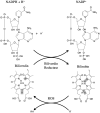Bile pigments in emergency and critical care medicine
- PMID: 36309733
- PMCID: PMC9618204
- DOI: 10.1186/s40001-022-00863-0
Bile pigments in emergency and critical care medicine
Abstract
Bile pigments, such as bilirubin and biliverdin, are end products of the heme degradation pathway in mammals and are widely known for their cytotoxic effects. However, recent studies have revealed that they exert cytoprotective effects through antioxidative, anti-inflammatory, and immunosuppressive properties. All these mechanisms are indispensable in the treatment of diseases in the field of emergency and critical care medicine, such as coronary ischemia, stroke, encephalomyelitis, acute lung injury/acute respiratory distress syndrome, mesenteric ischemia, and sepsis. While further research is required before the safe application of bile pigments in the clinical setting, their underlying mechanisms shed light on their utilization as therapeutic agents in the field of emergency and critical care medicine. This article aims to summarize the current understanding of bile pigments and re-evaluate their therapeutic potential in the diseases listed above.
Keywords: Antioxidant therapy; Bile pigments; Emergency and critical care medicine.
© 2022. The Author(s).
Conflict of interest statement
The author declares no competing interests.
Figures




Similar articles
-
The anti-mutagenic properties of bile pigments.Mutat Res. 2008 Jan-Feb;658(1-2):28-41. doi: 10.1016/j.mrrev.2007.05.001. Epub 2007 May 18. Mutat Res. 2008. PMID: 17602853 Review.
-
Metabolism of haem in Caco-2 cells.Exp Physiol. 2010 Feb;95(2):296-303. doi: 10.1113/expphysiol.2009.050203. Epub 2009 Oct 30. Exp Physiol. 2010. PMID: 19880533
-
Metabolism of biliverdin. Biliary excretion of bile pigments after intravenous injection of biliverdin isomers.Biochim Biophys Acta. 1976 Sep 24;444(2):333-7. doi: 10.1016/0304-4165(76)90375-5. Biochim Biophys Acta. 1976. PMID: 971411
-
Hemoglobin and iron-evoked oxidative stress in the brain: protection by bile pigments, manganese and S-nitrosoglutathione.Free Radic Res. 1999 Dec;31(6):631-40. doi: 10.1080/10715769900301201. Free Radic Res. 1999. PMID: 10630686
-
Antioxidant activities of bile pigments.Antioxid Redox Signal. 2004 Oct;6(5):841-9. doi: 10.1089/ars.2004.6.841. Antioxid Redox Signal. 2004. PMID: 15345144 Review.
Cited by
-
Association of Albumin-Bilirubin (ALBI) Grade With 28-Day All-Cause Mortality in Patients With Acute Respiratory Distress Syndrome: A Retrospective Analysis of the MIMIC-IV Database.Mediators Inflamm. 2025 Jul 14;2025:9930648. doi: 10.1155/mi/9930648. eCollection 2025. Mediators Inflamm. 2025. PMID: 40692980 Free PMC article.
-
Open-Chain Tetrapyrroles Meet Metal Ions in the Functional Molecular Material Science.Chempluschem. 2025 Jun;90(6):e202500090. doi: 10.1002/cplu.202500090. Epub 2025 Apr 6. Chempluschem. 2025. PMID: 40126191 Free PMC article.
-
Bilirubin metabolism in relation to cancer.Front Oncol. 2025 Apr 11;15:1570288. doi: 10.3389/fonc.2025.1570288. eCollection 2025. Front Oncol. 2025. PMID: 40291905 Free PMC article. Review.
-
Association of blood carboxyhemoglobin levels with mortality and neurological outcomes in out-of-hospital cardiac arrest.Acute Med Surg. 2025 Mar 23;12(1):e70053. doi: 10.1002/ams2.70053. eCollection 2025 Jan-Dec. Acute Med Surg. 2025. PMID: 40130086 Free PMC article.
References
-
- McDonnell M, Mohiuddin S. Biochemistry, biliverdin. Treasure Island: StatPearls Publishing; 2022. - PubMed
Publication types
MeSH terms
Substances
LinkOut - more resources
Full Text Sources

